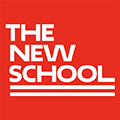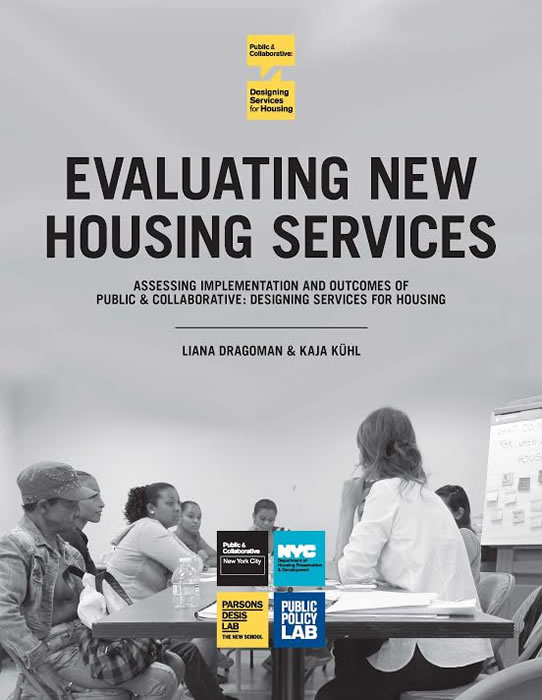nyc department of housing, preservation and development, public policy lab, and parsons desis lab complete two-year survey of affordable housing marketing and outreachPilot Program Results and Recommendations for Evaluating New Housing Services |
New York, NY – The New York City Department of Housing Preservation and Development (HPD), the Public Policy Lab (PPL), and the Design for Social Innovation and Sustainability Lab (DESIS) at Parsons The New School for Design have released Evaluating New Housing Services, a comprehensive assessment of the implementation of new services for those seeking city-supported affordable housing; the report is available as a free download from the PPL and Parsons websites. The partnership was made possible by a 2012 Rockefeller Foundation Cultural Innovation Fund grant. The partners engaged community residents, local organizations, and design professionals to inform the development of new programs that could simplify and clarify the process and requirements for applying for affordable housing developments subsidized by the City. HPD piloted several new marketing programs over the past year, including more user-friendly communications materials about the application process, new ways of sharing information about housing opportunities via local outreach and face-to-face agency interactions, and partnerships with community housing “ambassadors.” “The partnership with PPL and DESIS has transformed our ability to identify and respond to New Yorkers’ needs for information about housing opportunities,” said David Quart, HPD’s Chief of Staff and Deputy Commissioner of Strategy, Research, and Communications. “The application process is necessarily exhaustive, but it should not be a burden on applicants seeking affordable housing. Working within various communities to design more easily understandable materials and conduct outreach is not simply the smartest and most straightforward way to operate, it also strengthens connections between government and New Yorkers in a meaningful way.”
HPD worked independently and with private and non-profit partners to implement the four pilot programs proposed by the Public Policy Lab and Parsons DESIS.
The Public Policy Lab designed new flyers, guides, and process maps intended to assist applicants to HPD-sponsored housing and those who help them. These included a redesigned advertisement for rental lotteries accepting applications, a map of rental opportunities across the city, and clear, visually appealing guides for applying to housing and preparing for a screening interview.
HPD worked with the Housing Partnership and Wavecrest Management Team to pilot a hyper-local marketing approach in neighborhoods in which those organizations were advertising affordable housing. Staff posted advertisements for the affordable housing in nearby retail locations and community spaces, with the intention of reaching community residents who may not otherwise be aware of such opportunities nor seek them online.
To increase awareness of HPD and teach people how to start the application process through New York City Housing Connect, HPD piloted a street team, made up of staff from its Division of Marketing as well as the Public Education and Outreach unit. The team set up a table at an outdoor Brooklyn public event, and answered questions, provided materials, and demonstrated the online application system to a few hundred members of the public.
For a pilot period of six months, HPD designated as “ambassadors” four community-based organizations who currently assist people through the HPD lottery application process and provide guidance on affordable housing issues. The intention of this pilot was to extend up-to-date, consistent information and assistance about the application process beyond HPD's current reach, and to facilitate dialog with and among community groups who help applicants with housing. Through training, regular feedback sessions, and sharing information and materials, the agency and the organizations learned from and helped each other provide their respective services to affordable housing applicants.
HPD chose participants for the ambassador pilot based on their location, the types of housing that were going to be marketed during the pilot implementation cycle, and the work that the organizations were doing within multiple types of neighborhoods across New York City. The four initial participating organizations were Good Old Lower East Side (GOLES), Community League of the Heights (CLOTH), Churches United for Fair Housing (CUFFH), and Mutual Housing Association of New York (MHANY). Public Policy Lab fellows Liana Dragoman and Kaja Kühl used a range of techniques to evaluate the pilots, including an online survey of 2,500 applicants to housing lotteries, postcard surveys of people who interacted with HPD staff distributing information and answering questions, structured observation of outreach activities, and interviews with participants from HPD, community organizations, and affordable housing developers. “We launched this program in the belief that user-centered design approaches – including close collaboration with members of the public and service providers – can help to transform how government delivers public services,” said Chelsea Mauldin, executive director of the Public Policy Lab. “This thorough evaluation shows how a design-based innovation program generated positive responses and outcomes from residents, community partners, and HPD staff alike. We’re tremendously impressed by the work of our fellows, our partners, and the City in implementing and assessing the Public & Collaborative pilots.” "This extraordinary initiative showed us that greater openness and engagement by involving all stakeholders in the design and production of public services can create great benefits to New Yorkers, and moving forward, we are hopeful that participatory design will continue to gain traction as an everyday practice within government," said Eduardo Staszowski, director of Parsons DESIS Lab. HPD intends to build on the success of this partnership by continuing to strengthen and expand the newly formed information-sharing networks and communications channels it has initiated. “This has been a useful and educational exercise for everyone involved,” said Margaret Brown, HPD’s Assistant Commissioner of Policy and Operations in the Office of Asset & Property Management. “With the help of community partners and new audience-centered materials, we are extending the reach of information on housing opportunities beyond what we have been able to do in the past.” In May 2014, Parsons DESIS Lab hosted a one-day conference at The New School that brought together community members, academics, designers, and policymakers to report on the pilot outcomes and discuss public-sector innovation. The conference was marked by stimulating presentations and conversations around a growing set of sites and practices working to affect innovation in the public realm. Distinguished invited guests representing a broad international range of public and social labs presented and critically reflected on their current work within such spaces. The conversations initiated in the conference will be used to inform short essays and case studies to be published in the next edition of The Journal of Design Strategies (Parsons The New School for Design, forthcoming 2014). ### The New York City Department of Housing Preservation and Development (HPD) is the nation’s largest municipal housing preservation and development agency. Its mission is to promote quality housing and viable neighborhoods for New Yorkers through education, outreach, loan and development programs, and enforcement of housing quality standards. HPD is tasked with fulfilling Mayor de Blasio’s Housing New York: A Five-Borough Ten-Year Plan to build and preserve 200,000 affordable units for New Yorkers whose incomes range from very low incomes to those in the middle class. For more information visitwww.nyc.gov/hpdand for regular updates on HPD news and services, connect with us via www.facebook.com/nychpd andwww.twitter.com/nychousing. Parsons The New School for Design is one of the leading institutions for art and design education in the world. Based in New York but active around the world, the school offers undergraduate and graduate programs in the full spectrum of design disciplines. Critical thinking and collaboration are at the heart of a Parsons education. Parsons graduates are leaders in their respective fields, with a shared commitment to creatively and critically addressing the complexities of life in the 21st century. For more information, please visit www.newschool.edu/parsons. Parsons DESIS (Design for Social Innovation and Sustainability) Lab is a research laboratory based at The New School University. DESIS Lab works at the intersection of strategic and service design, management, and social theory, applying interdisciplinary expertise in problem setting and problem solving to sustainable practices and social innovation. For more information visit DESIS website, http://www.newschool.edu/desis, or on Twitter at @desisparsons. The Public Policy Lab is a nonprofit organization that helps Americans build better lives by improving the design and delivery of public services. In support of this mission, the Public Policy Lab partners with government agencies to develop pragmatic, replicable solutions through user-centered research, design prototyping, testing, and evaluation. Find out more on PPL's website, www.publicpolicylab.org, or on Twitter at @publicpolicylab. Contact: Juliet Morris (HPD) -- 212.863.5682, [email protected] Chelsea Mauldin (Public Policy Lab) -- 646-535-6536, [email protected] Eduardo Staszowski (New School) -- [email protected] |
 |
MARKETING AND COMMUNICATION |
| 79 Fifth Avenue New York, NY 10003 www.newschool.edu |
PRESS RELEASE |
Media Contacts: Scott Gargan, Press Officer |
|
|
